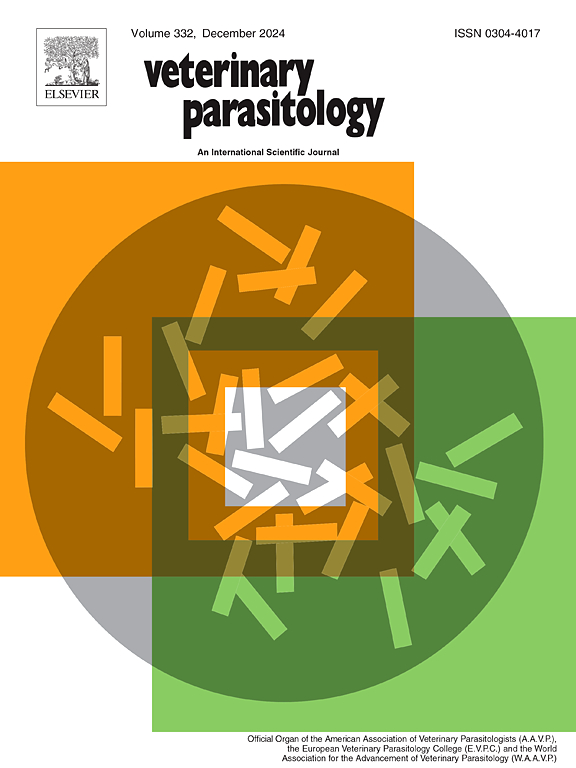依普诺菌素5 mg/mL外用溶液以1 mg / kg体重给药两次对绵羊疥疮病的疗效
IF 2
2区 农林科学
Q2 PARASITOLOGY
引用次数: 0
摘要
羊的疥疮病是一种皮肤病,危害动物的健康和福利,影响其生产力,并且是人畜共患的。在欧洲,肉毒杆菌病似乎是影响地中海国家为产奶而饲养的羊的主要病种。Eprinomectin 5 mg/mL外用溶液(EPRINEX®Multi,勃林格殷格翰公司)最近在欧洲几个国家被批准用于治疗胃肠道和肺部线虫以及零小时停奶的绵羊发情期。由于该产品对牛具有抗包括疥螨在内的多种寄生虫的功效,因此在希腊进行的两项实地疗效研究(每项研究25只羊)和一项对照蒙面临床研究(22只羊)中,评估了该产品对天然获得性疥疮感染的奶羊的治疗效果。在实地研究中,所有动物两次,间隔两周(第0天和第14天),依普利诺菌素5 mg/mL外用溶液,每只动物14 mL,根据每项研究中视觉估计最重的5只动物的体重进行倾倒。在对照研究中,通过减少治疗前的活螨数量对动物进行排名,将两只动物分成一组,随机分为两组,一组不进行治疗(对照组),另一组两次,间隔两周,以每5 公斤体重1 毫升的剂量注射依普诺菌素5 mg/mL局部溶液。在治疗前和第一次治疗后每隔8周收集一次皮肤刮痕,以建立活疥螨计数。在每次抽样时,使用5类评分系统为每只动物建立一个“临床评分”。依普诺菌素5 mg/mL外用溶液处理的动物的螨计数在处理后的所有情况下均显著(p <; 0.0001)低于现场研究中处理前的计数或对照研究中对照组的计数。所有处理过的动物在第一次治疗后的28天以及随后的几次治疗中,活螨计数为零,直到研究结束(第56天)。在对照研究中,所有未经治疗的动物在整个研究过程中都有感染。eprinomectin 5 mg/mL外用溶液处理动物的临床评分,与现场研究中动物的治疗前评分或对照研究中对照组的评分相比,分别从第7天或第14天显著提高(p <; 0.05)。在研究结束时,61只接受治疗的绵羊中有56只皮肤健康,没有表现出与疥疮相关的临床症状,而5只动物尽管在四周内螨虫计数为零,但仍出现小的皮肤发红和一些瘙痒。所有动物都很好地接受了这些治疗,在整个研究过程中没有观察到任何健康问题。这一系列的研究表明,eprinomectin 5 mg/mL外用溶液两次,间隔两周,是一种有效和安全的治疗绵羊疥疮的方法。本文章由计算机程序翻译,如有差异,请以英文原文为准。
Efficacy of eprinomectin 5 mg/mL topical solution administered twice pour on at 1 mg per kg body weight against sarcoptic mange (Sarcoptes scabiei) in sheep
Sarcoptic mange of sheep is a skin disease which compromises the health and welfare of the animals, impacts their productivity and is zoonotic. In Europe, sarcoptic mange appears to be the prevailing type of mange affecting sheep kept for milk production in the Mediterranean countries. Eprinomectin 5 mg/mL topical solution (EPRINEX® Multi, Boehringer Ingelheim) was recently authorized for the treatment of gastrointestinal and pulmonary nematodes and Oestrus ovis in sheep with zero hours milk withdrawal in several countries in Europe. As the product in cattle has claims against a broad range of parasites including sarcoptic mange mites, the therapeutic efficacy of the product was evaluated in dairy sheep with naturally acquired S. scabiei infestation in two field efficacy study (25 sheep per study) and one controlled, masked clinical study (22 sheep) conducted in Greece. In the field studies, all animals were administered twice, two weeks apart (Days 0 and 14), eprinomectin 5 mg/mL topical solution at 14 mL per animal pour on, based on the body weight measured for the visually estimated heaviest five animals in each study. In the controlled study, animals were ranked by decreasing pre-treatment live mite count, formed in blocks of two animals and randomly assigned to one of two groups to remain untreated (control) or to be administered twice, two weeks apart, eprinomectin 5 mg/mL topical solution at 1 mL per 5 kg body weight pour on. Skin scrapings were collected prior to treatment and at intervals for eight weeks after the first treatment to establish live Sarcoptes mite counts. A ʽMange Clinical Scoreʼ was established for each animal using a 5-category scoring system at each sampling. Mite counts of the eprinomectin 5 mg/mL topical solution-treated animals were significantly (p < 0.0001) lower than the pre-treatment counts in the field studies or those of the controls in the controlled study, on all occasions post-treatment. All treated animals had zero live mite counts at 28 days after the first treatment and at the subsequent occasions until the end of the studies (Day 56). All untreated animals in the controlled study remained infested throughout the study. The ʽMange Clinical Scoreʼ of the eprinomectin 5 mg/mL topical solution-treated animals, compared either to the pre-treatment scores in the animals in the field studies or to the scores of the controls in the controlled study, improved significantly (p < 0.05) from Day 7 or Day 14, respectively. At the end of the studies, 56 of the 61 treated sheep had healthy skin and did not show clinical symptoms associated with sarcoptic mange, while five animals still presented small, reddened skin areas and some itching despite demonstrating zero mite counts over four weeks. The administration of the treatments was well accepted by all animals and no health problems were observed throughout the studies. This series of studies demonstrated eprinomectin 5 mg/mL topical solution when administered twice, two weeks apart, to be an efficacious and safe treatment against ovine sarcoptic mange.
求助全文
通过发布文献求助,成功后即可免费获取论文全文。
去求助
来源期刊

Veterinary parasitology
农林科学-寄生虫学
CiteScore
5.30
自引率
7.70%
发文量
126
审稿时长
36 days
期刊介绍:
The journal Veterinary Parasitology has an open access mirror journal,Veterinary Parasitology: X, sharing the same aims and scope, editorial team, submission system and rigorous peer review.
This journal is concerned with those aspects of helminthology, protozoology and entomology which are of interest to animal health investigators, veterinary practitioners and others with a special interest in parasitology. Papers of the highest quality dealing with all aspects of disease prevention, pathology, treatment, epidemiology, and control of parasites in all domesticated animals, fall within the scope of the journal. Papers of geographically limited (local) interest which are not of interest to an international audience will not be accepted. Authors who submit papers based on local data will need to indicate why their paper is relevant to a broader readership.
Parasitological studies on laboratory animals fall within the scope of the journal only if they provide a reasonably close model of a disease of domestic animals. Additionally the journal will consider papers relating to wildlife species where they may act as disease reservoirs to domestic animals, or as a zoonotic reservoir. Case studies considered to be unique or of specific interest to the journal, will also be considered on occasions at the Editors'' discretion. Papers dealing exclusively with the taxonomy of parasites do not fall within the scope of the journal.
 求助内容:
求助内容: 应助结果提醒方式:
应助结果提醒方式:


